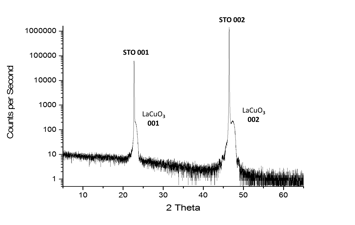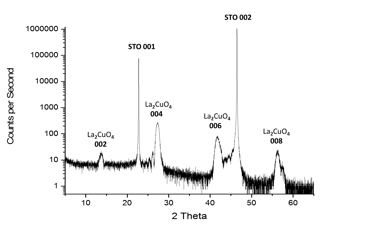Reports: UNI1055121-UNI10: Engineering Superior Oxide Catalysts via Electrostatic Strain
Brittany B. Nelson-Cheeseman, PhD, University of St. Thomas
Major Goals
The overarching goal of this project is to realize material design strategies that increase the activity of transition metal oxides (TMO) in order to increase the efficiency of petroleum-relevant catalytic processes in applications such as solid oxide fuel cells. In particular, this project focuses on advancing a method of custom atomic ordering in known layered transition metal oxides that alters the local structure and bonding, resulting in improved catalytic materials properties. This project also contributes to the interdisciplinary training of undergraduates in a variety of settings, and exposes them to research in petroleum-relevant fields.
Accomplishments Towards These Goals
The PI and eight undergraduate students have grown and characterized over 25 thin films at the University of Minnesota (UMN), Argonne National Laboratory (ANL), and the University of St. Thomas. As reported in the 2016 Annual Report, a custom Janis electrical transport system has been successfully setup at UST for electrical transport measurements.
As described in the 2016 Annual Report, the group was able to successfully grow and characterize the structure and transport of La2-xSrxCuO4 epitaxial films (x=0-1). The supported work found that increasing the Sr content from x=0 to x=1.0 causes a peak in the c-axis lattice parameter and the roughness values near x=0.50. The films were smooth and crystalline, exhibiting similar electric properties as are found in bulk samples. The ability to create ultrathin films at high Sr levels shows promise for the potential of inducing novel electric properties through cation ordering and interfacial effects. The journal article manuscript detailing this work has just received an editor recommendation of “publish with minor revisions” in a peer-reviewed journal, and publication should be forthcoming.
This program had some significant infrastructure setbacks, as detailed in the 2016 Annual Report. As a result, the project pivoted to investigating La,Cu-heterostructures made up of the 3D perovskite LaCuO3- d (LCO113) and the 2D layered perovskite La2CuO4+d(LCO214) (Figure 1). Both are simultaneous electronic and ionic conductors of interest for fuel cell cathode applications similar to the original proposed work. While each material has complementary benefits and drawbacks for oxygen ion incorporation and diffusivity, a combination of the two materials may mitigate these drawbacks, while enhancing the total benefits. Unexpected emergent effects may also present themselves. Thus, the group pursued investigations of how the electrical properties are modified when LCO113 and LCO214 are brought together in epitaxial layered heterostructures. Both single films of LCO113 and LCO214 were successfully grown and exhibit an epitaxial nature as shown by X-ray diffraction data (Figures 2 and 3). Data from X-ray reflectivity data (XRR) and Reflective High Energy Electron Diffraction (RHEED) during growth (not shown) also demonstrate the smooth nature of the single films. A bilayer of the two materials was also grown as shown in Figure 4. Unfortunately, the crystallinity of the bilayer was not as robust as that of the single films, although it did still maintain fairly low film surface roughness, as demonstrated by XRR and RHEED data (not shown).
Figure 1. Crystal structure comparison of layered cuprate La2CuO4 and 3-dimensional network perovskite LaCuO3. Green represents La. Gray polyhedra represent Cu-O octahedra. Blue rectangular prism demonstrates material’s unit cell.
Figure 2. X-ray diffraction of epitaxial LaCuO3-d film on SrTiO3(001).
Figure 3. X-ray diffraction of epitaxial La2-xSrxCuO4+d film on SrTiO3(001).
Figure 4. X-ray diffraction of epitaxial LaCuO3/La2-xSrxCuO4 bilayer film on SrTiO3(001).
The electrical properties of the three types of films were investigated and are displayed in Figure 5. While the LCO113 film displays metallic behavior, the LCO214 film displays insulating behavior. The bilayer displays semiconducting behavior between the two end members. This work is currently being finalized for submission as a peer-reviewed journal article.
Figure 5. Electrical resistivity as a function of temperature for La2-xSrxCuO4 films.
Opportunities for Training and Professional Development Provided by This Grant
This project has provided eight mechanical engineering undergraduate students from the University of St. Thomas (UST) with extensive experimental training not normally found at the undergraduate level. This includes being trained to operate, collect and analyze data from molecular beam epitaxy (MBE), reflective high energy electron diffraction (RHEED), X-ray diffraction (XRD), X-ray reflectivity (XRR), Atomic Force Microscopy (AFM), metal DC sputtering, and electrical resistivity measurements (4-point and Van der Pauw) as a function of temperature. Additionally, the students constructed and optimized the custom electrical transport system used for their electrical transport measurements. The students have performed these experiments in a variety of locales, which exposes them to the diversity of settings in which research is conducted. These locales include an undergraduate lab at their home RUI institution (UST), a graduate lab at an R1 institution (UMN, Dept of Physics), and two shared facilities labs—one at an R1 institution (UMN, Characterization Facility) and one at a national laboratory (ANL, Center for Nanoscale Materials). In addition to lab training, the students have also practiced how to communicate their progress and results through creating and presenting posters at local (“Inquiry at UST”) and national venues (American Physical Society March Mtg in Baltimore, MD and Materials Research Society in Phoenix, AZ), as well as working to develop two technical manuscripts for peer-reviewed journal articles. Through this program, the PI has gained significant training and professional development in how to manage the activities, budget, and reporting for an external grant. In particular, she has learned how one can be resourceful and move a program forward in the face of setbacks or obstacles that deter the original proposed plan.

















